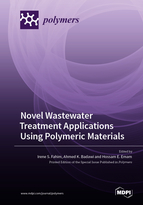Novel Wastewater Treatment Applications Using Polymeric Materials
A special issue of Polymers (ISSN 2073-4360). This special issue belongs to the section "Polymer Applications".
Deadline for manuscript submissions: closed (10 November 2022) | Viewed by 53078
Special Issue Editors
Interests: biocomposites; tensile strength; chitosan
Special Issues, Collections and Topics in MDPI journals
Interests: nanomaterials; adsorption; photocatalysis; polymeric nanocomposites; solid waste engineering
Special Issues, Collections and Topics in MDPI journals
Interests: cellulose; fibers/fabrics treatment; functional textiles; nanoparticles
Special Issues, Collections and Topics in MDPI journals
Special Issue Information
Dear Colleagues,
Recently, water purification and the reuse of polluted wastewater have emerged as worldwide problems. However, it is extremely difficult to prevent organic contaminants and harmful heavy metals from polluting water at the present levels of industrialization and urbanization. As a result, finding effective technology to properly treat water and wastewater is required. Polymers have excellent properties, including superior stability and high surface area for rapid decontamination along with selectivity to eliminate various pollutants with cost-saving treatment processes. There are a variety of effective techniques capable of achieving positive outcomes regarding treated water quality, treatment time, energy consumption and sustainability requirements. These techniques include coagulation, flocculation, adsorption, photocatalysis, filtration and the use of membranes, which can be achieved through the use of polymeric materials. The applications of novel standalone polymeric-based technology are critical to successfully eliminate a variety of organic and inorganic impurities concurrently from water and wastewater. The main topic that we will focus on in the present Special Issue (SI) is suggesting some practical, sustainable and eco-friendly solutions based on novel polymeric materials, highlighting their applications in water and wastewater treatment. Assessment of the chemical, physical and morphological characteristics of polymers and their optimization by using different research tools is an important research aim about which we encourage submissions for inclusion in this SI, supported by the feasibility and efficiency of the suggested solutions.
Dr. Irene S. Fahim
Dr. Ahmed K. Badawi
Dr. Hossam E. Emam
Guest Editors
Manuscript Submission Information
Manuscripts should be submitted online at www.mdpi.com by registering and logging in to this website. Once you are registered, click here to go to the submission form. Manuscripts can be submitted until the deadline. All submissions that pass pre-check are peer-reviewed. Accepted papers will be published continuously in the journal (as soon as accepted) and will be listed together on the special issue website. Research articles, review articles as well as short communications are invited. For planned papers, a title and short abstract (about 100 words) can be sent to the Editorial Office for announcement on this website.
Submitted manuscripts should not have been published previously, nor be under consideration for publication elsewhere (except conference proceedings papers). All manuscripts are thoroughly refereed through a single-blind peer-review process. A guide for authors and other relevant information for submission of manuscripts is available on the Instructions for Authors page. Polymers is an international peer-reviewed open access semimonthly journal published by MDPI.
Please visit the Instructions for Authors page before submitting a manuscript. The Article Processing Charge (APC) for publication in this open access journal is 2700 CHF (Swiss Francs). Submitted papers should be well formatted and use good English. Authors may use MDPI's English editing service prior to publication or during author revisions.
Keywords
- wastewater treatment
- eco-friendly solution
- polymeric materials
- flocculants
- adsorbent
- hybrid polymers in water treatment
- inorganic semiconductors in water treatment









